The PG guide to demystifying boost, overdrive, distortion, and fuzz.
Rock music and distortion have pretty
much always gone hand in hand. But
what is it we mean by “distortion,” and how
does it differ from “overdrive” and “fuzz”? A
quick perusal of the intergoogle easily turns
up hundreds of pedals laying claim to one
or another of those appellations. One site
offers 50 pedals with the word “distortion”
in the name, and Boss alone makes five different
distortion pedals. The names of other
pedals give no clue as to whether they are
overdrive, boost, distortion, or fuzz. (Way
Huge Fat Sandwich, anyone?) More definition
complications ensue when we add amp
distortion and booster pedals to the mix.
So how, exactly, do we determine whether
a pedal provides a boost, overdrive, distortion,
or fuzz effect—particularly when a
given model may perform more than one
function? To start unraveling this mess, we
need to get technical for a minute.
Catch a Wave
You might have heard the term “sound
waves.” It refers to the fact that sound
travels in waves similar in some ways to
the ones we see in the ocean: If you put a
clean audio signal through an oscilloscope,
you will see a line with smoothly rounded
peaks and valleys. When an amplifier
reaches a level at which it can no longer
increase the output signal without altering
the input signal, that is called distortion (it’s
also known as clipping). On the ’scope, this
distortion shows up as flattened peaks and
valleys rather than the previously rounded
peaks and valleys. This is true of instrument
amplifiers as well as pedals, which use tiny
amplifiers in their circuitry. Distorting a
signal adds harmonic content or overtones
that did not exist in the original. These
overtones are actually present in everything
from bird songs to flutes and cellos—yes,
Virginia, there was distortion before rock ’n’
roll—and they add much of the character
we love in so many guitar tones.
The amount that the waveform is
squashed by this distortion goes a long way
toward defining the difference between
overdrive, distortion, and fuzz. A clean
boost pedal’s job is to increase the output
of your guitar signal only enough to give
you extra volume or drive your amp to
distort, without adding any grit of its own.
An overdrive pedal adds some distortion to
the signal but not a lot, while a distortion
effect crushes the wave pretty heavily—and
fuzz even more so.
In addition to adding extra harmonics to
the signal, the squashing effect of distortion
also compresses it, thus reducing the attack
and dynamic range while adding sustain
similar to what you’d get from an MXR
Dyna Comp or another compressor pedal.
Now that we understand a bit about the
technical differences of boost, overdrive,
distortion, and fuzz, let’s take a look at how
this plays out in the world of sound and tone.
Stacking the Deck
We’ve all heard the “plug-me-straight-in”
philosophy from those who claim nothing
beats the sound of a great guitar plugged into
a great tube amp, without any pedals between
them. Given the right instrument, the right
stack or combo, the right player, and the
right circumstances, it is hard to refute that
theory: The tone produced by power tubes
being pushed past their limit is hard to beat.
And though preamp distortion—the
distortion that comes from the EQ circuit
rather than from driving the amp’s power
section beyond what it can output without
distorting—has come a long way since
the days of the silverface Master Volume-equipped
Fender Twin, the sound sought
by most adherents to the “plug-me-straight-in”
philosophy is most definitely that of
power tubes working hard. In the case of
the earliest tube amps, the sound is attained
by working them much harder than the
designers originally intended. Crank up a
Fender Deluxe, Vox AC30, Marshall plexi,
or a boutique clone of a vintage amp, and
the resulting distorted tone is a thing of
beauty that’s highly responsive to pick
attack and guitar-volume control. There
is just one problem: These amps only
achieve this sound within a limited range of
volume. In other words, the amp has to be
loud to get that sound.
If you only play in your basement or studio,
with no complaining neighbors or family—problem solved. You can use an amp at
its optimal volume to your heart’s content.
When you play out in clubs, theaters, or
even arenas, however, you will often find
the sweet-spot volume to be either too loud,
or in the case of smaller combos, not loud
enough. If it’s too loud, you’ll probably
be asked to turn down until all that lovely
distortion turns into a clean “plink.” If it’s
too soft, you might find yourself turning up
until your gorgeous, open, singing sound is
converted into a raspy, overly compressed
mosquito buzz.

However, if you’re committed to this type of grit, there are solutions:
- Power attenuators like the Rivera RockCrusher (street $499, rivera.com, reviewed June 2011) and THD Hot Plate (street $328, thdelectronics.com) can be placed between your amp’s speaker output and speakers to lower the volume without having to turn down the amp. You will lose the part of the tone that is caused by the speaker breaking up, but it should get you pretty close to that “plug-me-straight-in” sound.
- Some players put a Plexiglas sheet in front of their speakers to reduce the stage volume. While this makes soundmen, bandmates, and the first couple of rows happy, it will seriously alter what you hear onstage.
- Some higher-powered amps (such as a Fender Twin Reverb) will still work properly if you pull half of their power tubes (two of the four, in the case of the Twin) to drive them harder and get cranked tones at lower volumes. Check with the manufacturer before you try this.
- Bring several amps of differing wattage to your gig. At soundcheck, determine which one enables you to get the tones you want without excessive volume.
Booster Club
If you’ve decided you like the sound of your amp breaking up, but your guitar isn’t driving it quite hard enough to give you the grit and sustain you seek, you’re a candidate for a booster pedal like the Electro- Harmonix LPB-1 (street $39, ehx.com), an MXR Micro Amp (street $69, jimdunlop.com), or a Fuchs Plush Pure Gain (street $179, fuchsaudiotechnology.com). These pedals are designed to increase the output signal of your instrument without coloring the sound.
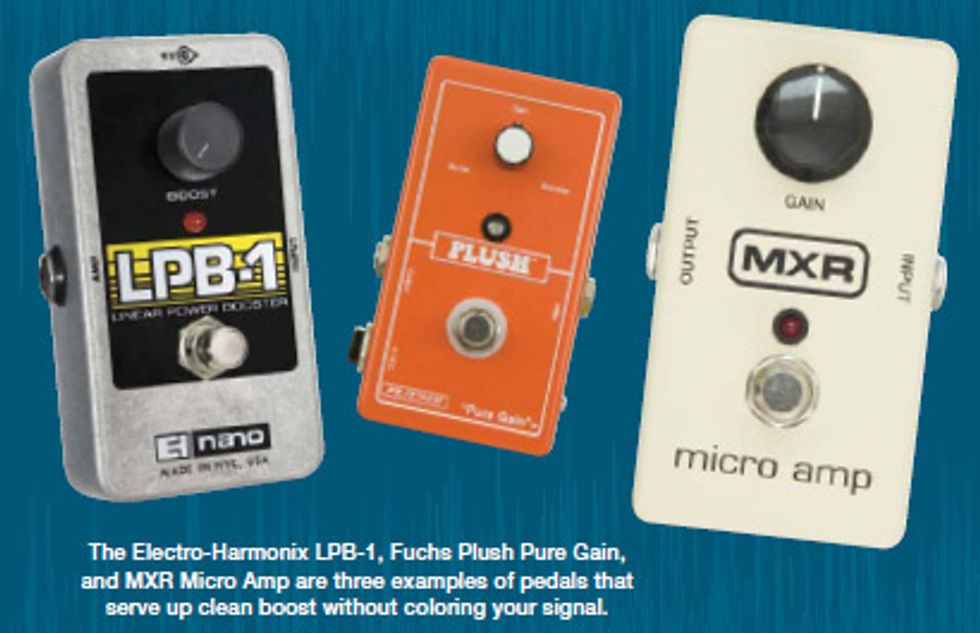
A pure booster pedal will have no tone controls or drive functions, but many booster pedals offer the option of desirable tone coloration or extra drive functions to expand their usefulness. The Keeley Katana (street $199, robertkeeley.com) serves up unadulterated boost, but if you pull up on the Volume knob it adds extra drive. The Xotic EP Booster (street $116, xotic.us) has only a Volume control, yet also aims to color your signal in a manner reminiscent of the old Echoplex tape-delay units used by Eric Johnson and Jimmy Page. It also offers internal switches to boost bass or treble frequencies. Many other boost pedals also offer overdrive options, leading to an overlap with effects labeled as overdrives.
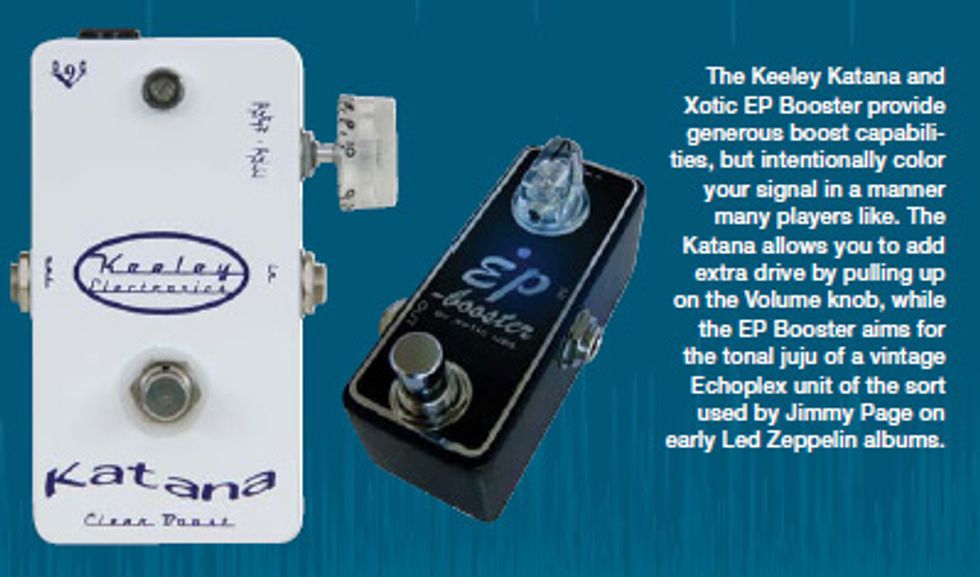
One kind of coloring boost pedal that remains somewhat misunderstood is the germanium boost. Germanium transistors were employed in many of the early power boosters and fuzz pedals used by the classic British guitarists of the 1960s. One of the most famous was the Dallas Rangemaster Treble Booster. Even today, debate rages as to whether a germanium transistor-based booster was ever used by Eric Clapton on the seminal Bluesbreakers “Beano” record, but there’s no doubt that driving an amp with such a device will bring you significantly closer to the legendary tones of the British Invasion era.
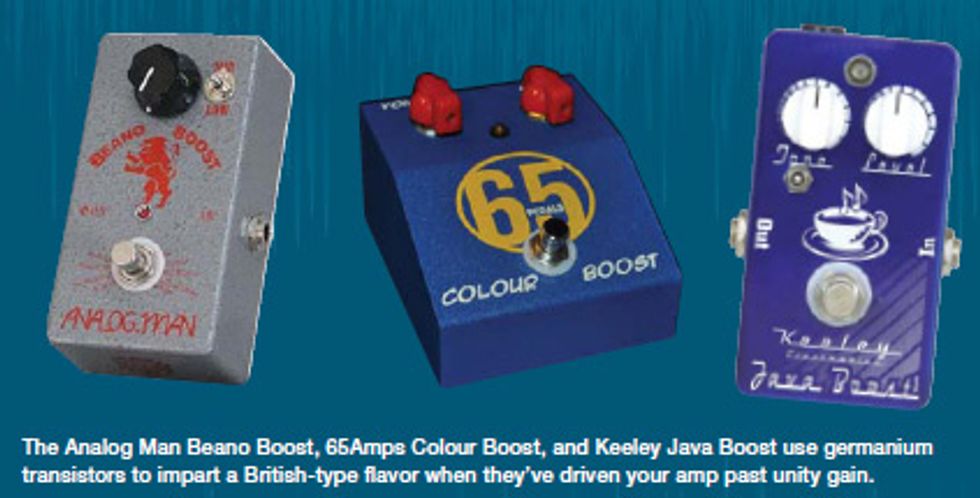
If you choose to use a germanium power boost like the Analog Man Beano Boost (street $175, analogman.com), 65Amps Colour Boost (street $229, 65amps.com), or Keeley Java Boost (street $229, robertkeeley.com), there are a few things to keep in mind:
- These are boost pedals: They will not impart distortion to a clean amp at unity gain (meaning the output signal of the pedal is the same level as the input signal). To generate distortion, you need to be pushing the amp with the pedal. This means the output of the activated pedal will be significantly louder than when it’s bypassed.
- They will impart a “British” sound—even to “American”-sounding amps. So if you’re looking for Robben Fordstyle, Dumble-like smoothness, they aren’t suitable.
- As with any boost pedal, germanium boosts sound best if the amp is already overdriven a little when the guitar volume is maxed.
- A germanium boost will impart its character any time it is on, even if you roll off your guitar volume and play clean.
In the Overdriver’s Seat
The next step up in the saturation chain is the overdrive pedal. As previously mentioned, with overdrives there can be considerable overlap with boost pedals. Many overdrives are used for boosting the amount of amp overdrive as well as adjusting the tone and adding extra dirt to the signal.
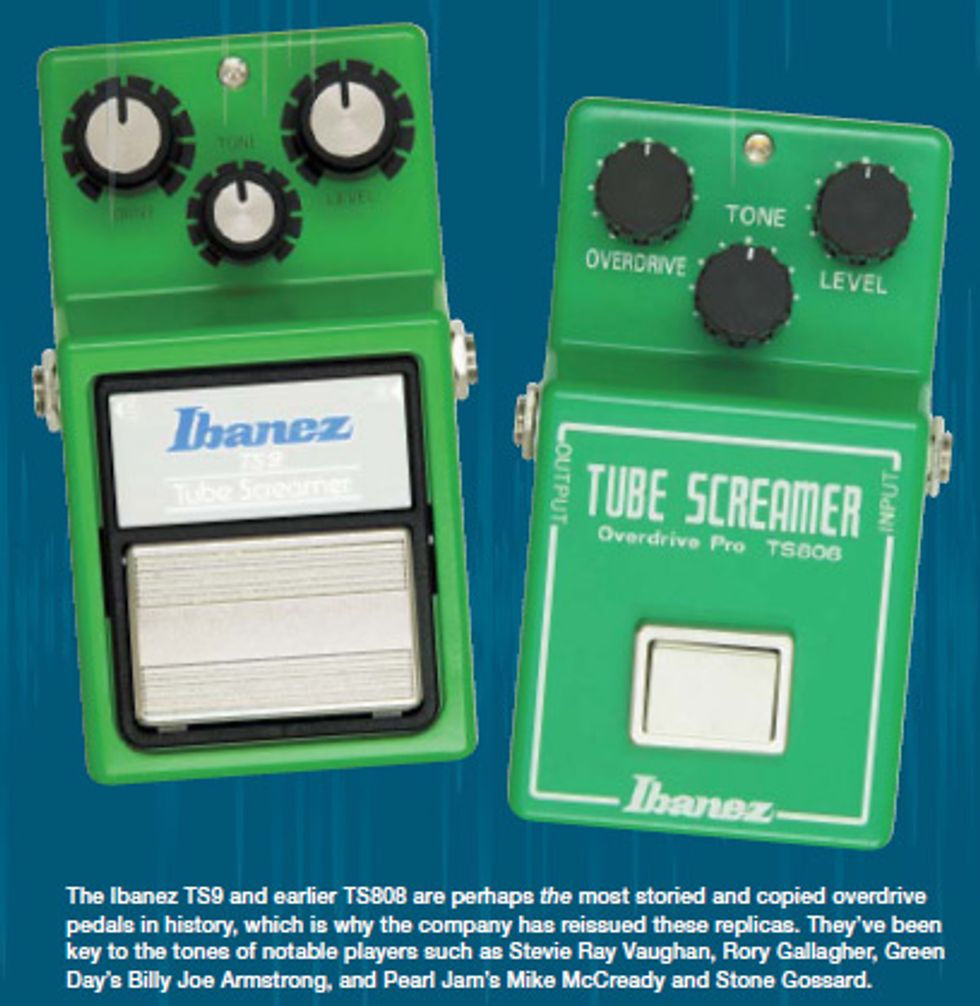
The Ibanez TS9 Tube Screamer (street $99, ibanez.com) and TS808 Tube Screamer (street $179) are touchstones of overdrive in that most other overdrive effects are compared to and/or contrasted with them. While TS9-style overdrives can impart enough distortion for lead work at unity gain, quite often they are employed as boost pedals with some added grit. By keeping the overdrive low, the level high, and using them with an amp that’s slightly distorted, you can preserve more of your amp’s tone and hear less of the pedal’s.
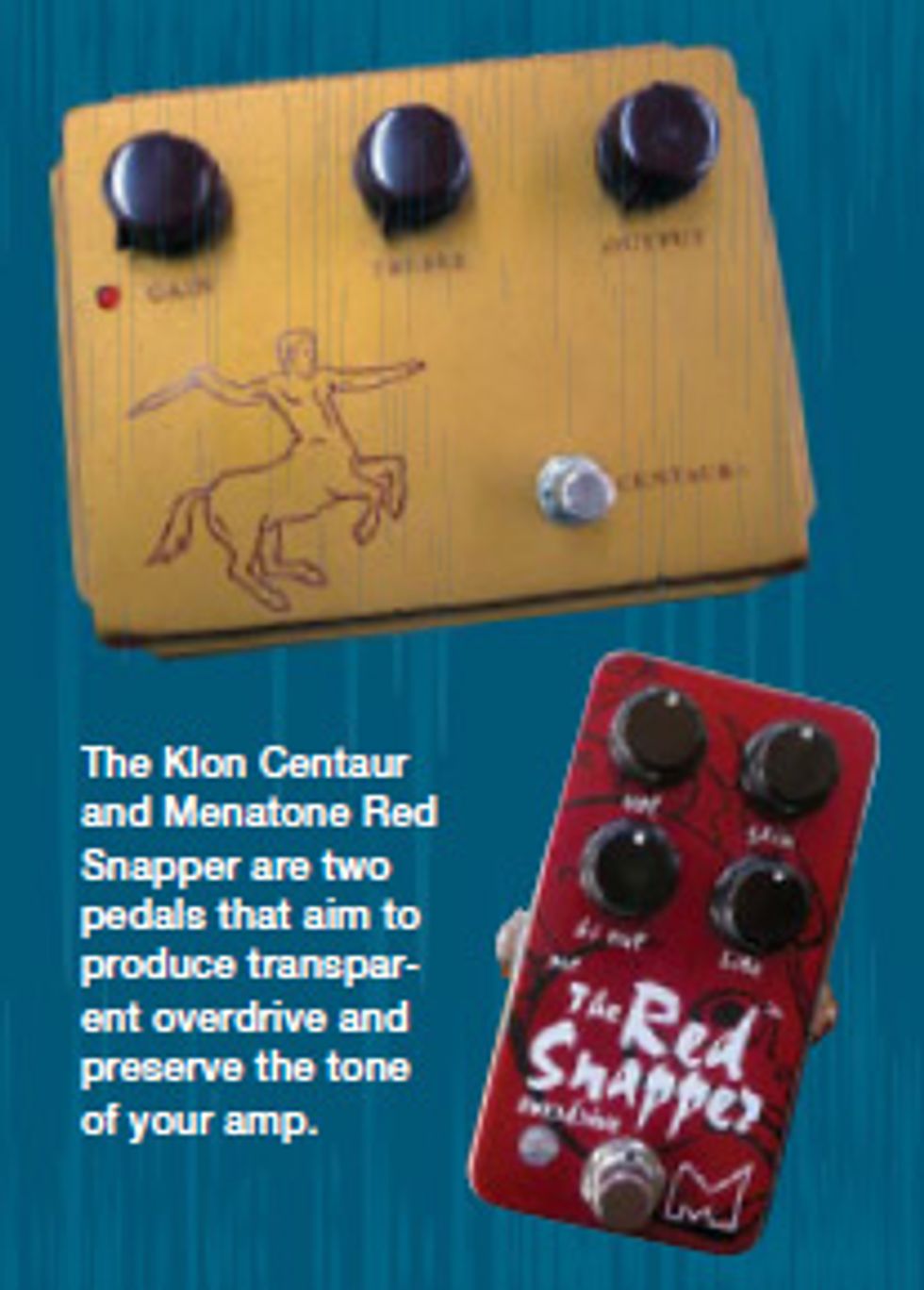
Overdrive users fall largely into two camps: those who want the pedal to be as transparent as possible so the resulting sound is close to the sound of their amp—the Klon Centaur (currently out of production, though reissues are reportedly in the works) and Menatone Red Snapper (street $179, menatone.com) are popular choices for this camp—and those who like the coloration offered by a pedal like a Tube Screamer or the Dumble-esque Hermida Zendrive (street $199, hermidaaudio.com).
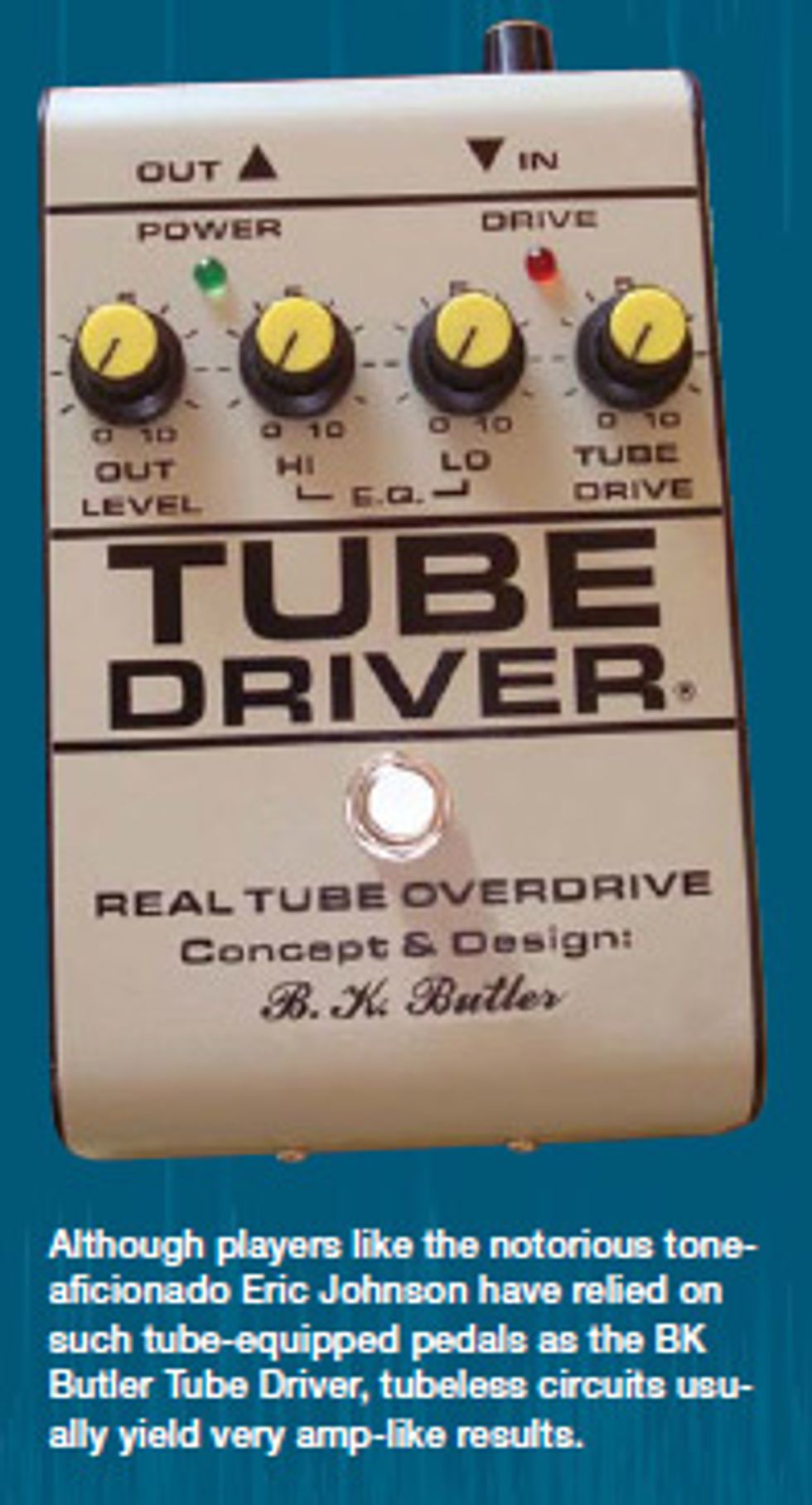
How can you tell if you’re dealing with an overdrive or a distortion pedal? With an overdrive pedal engaged, it will be easier to clean up your sound by backing off your guitar volume than it will be with a distortion pedal. The maximum gain you get should be nowhere near metal-appropriate levels when played through a clean amp. An overdrive pedal’s drive usually attempts to sound like the power tubes of an amp pushed into distortion, while a distortion pedal sounds more like . . . well, a pedal.
Some overdrive pedals, such as the classic BK Butler Tube Driver used by Eric Johnson, incorporate an actual tube in their circuitry. While using a tube to approximate tube distortion might seem like a no-brainer, glass tubes are fragile. Most guitarists find that smaller, tubeless pedals can get them close enough to an amp-like sound.
If your music tends towards lighter pop, basic blues, or jazz-fusion, an overdrive pedal should be where you start looking— though metal players are known to use an overdrive to boost a solo over the top.
Distorting: The Facts
The line between overdrive and distortion pedals can be even fuzzier (no pun intended) than between overdrives and boosts. After all, both types of pedals distort the sound, add volume, and often have tone controls. Some pedals, like the classic Pro Co Rat (street $94, procosound.com), offer a range of grit from smooth overdrive to near-fuzz rasp, but a distortion pedal generally squashes the wave flatter than an overdrive. As mentioned previously, this distortion of the sound wave is called clipping. An overdrive pedal engages in “soft” clipping, while a distortion effect is said to produce “hard” clipping.
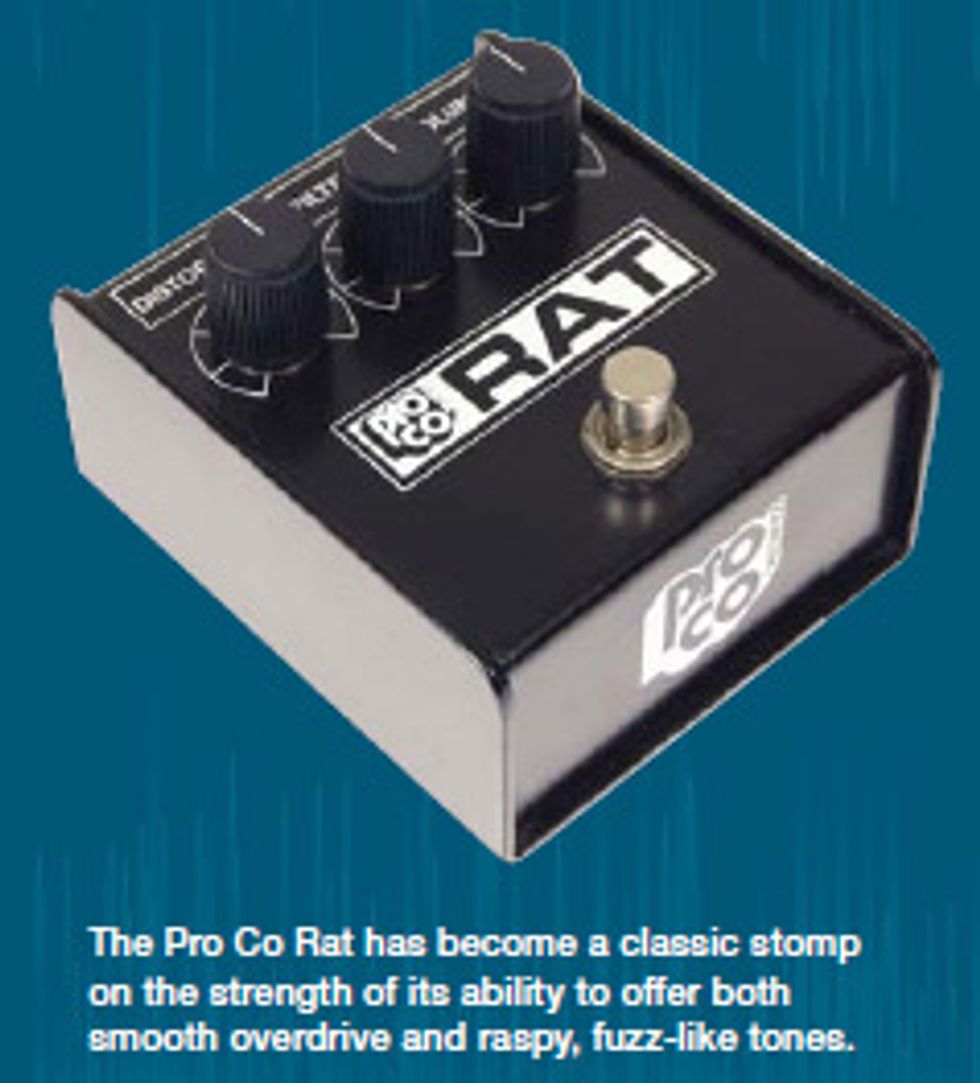
The oft-asked question, “What is the best distortion pedal?” is impossible to answer (as it is for any pedal). The aforementioned 50 distortion pedals available on a single website represent a range of “flavors” equivalent to a Penzey’s spice catalog. It’s like asking, “Which is better—cumin, tarragon, cinnamon, or cardamom?” Distortion pedals impart distinct character to your tone. Some impart a British-style attitude, while other add a heavier, more saturated flavor reminiscent of Mesa/ Boogie’s famous Dual Rectifier amps.
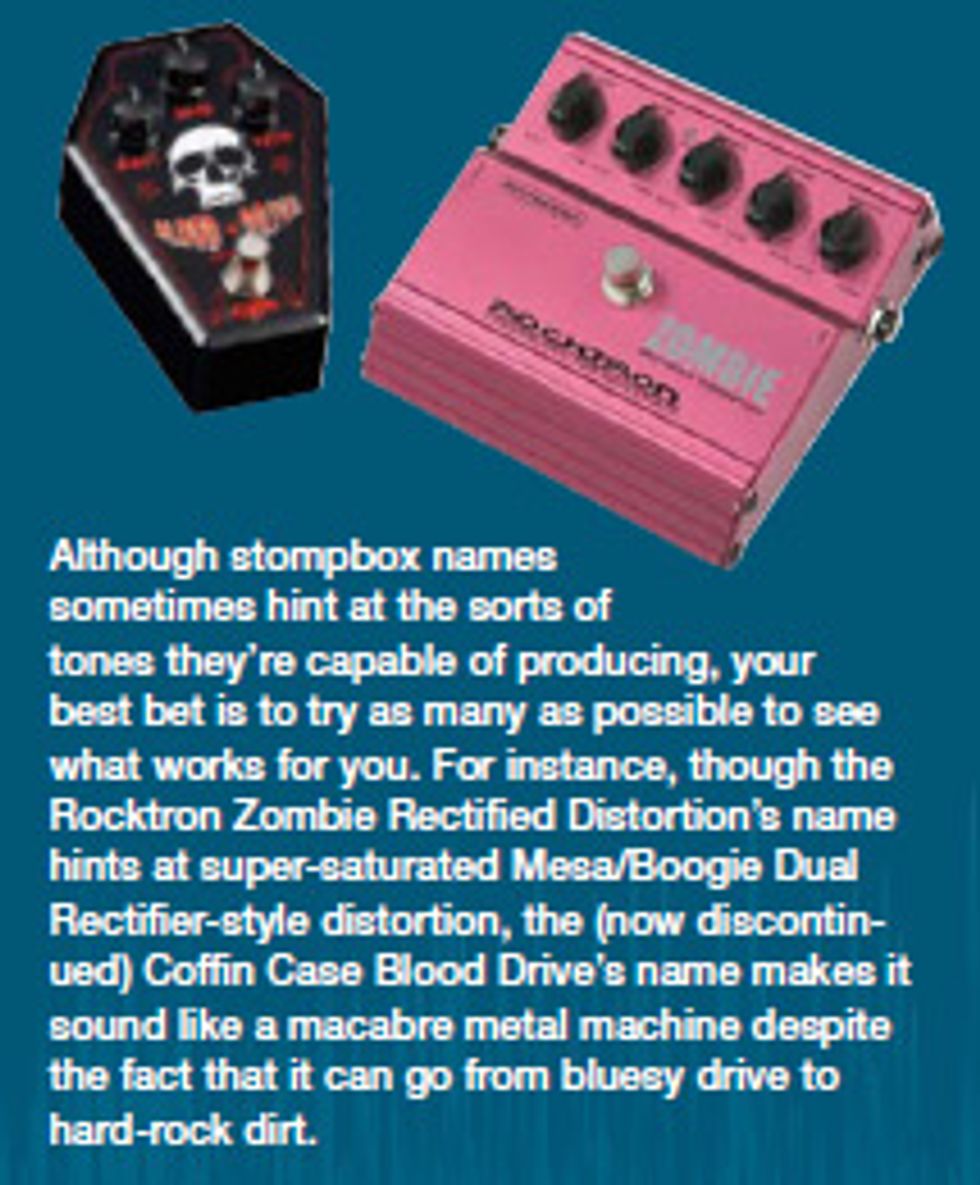
Because of that, you’re going to have to try a bunch to get a feel for what suits you, because the names can be pretty confusing. While it is a good bet that the Rocktron Zombie Rectified Distortion (street $79, rocktron.com) is suitable for modern metal, you might never guess that the Coffin Case BDFX-1 Blood Drive Distortion (discontinued) is a very warm- and classic-sounding distortion that will work well for everything from blues to hard rock.
Distortion pedals are best used with a minimum of amp gain, otherwise it’s easy to end up with a muddy and indistinct tone. Distortion boxes do not respond as well as overdrives to attack and guitar-volume control, but they are great for placing before a volume pedal in order to get massive rock sounds at a volume that’s comfortable for a wedding or Bar Mitzvah gig.
Fuzzy Thinking
You would think that a fuzz effect would be easily distinguishable from an overdrive or distortion—and some are—but others blur the line. Technically, there is a difference—distortions and overdrives usually use diodes and op-amps to achieve breakup, while fuzzes use transistors—but, sonically and feel-wise, there can be crossover.
Fuzz-pedal transistors can be of either the germanium or silicon variety. The first fuzz pedals used germanium transistors, and some players prefer these to later silicon transistors because they consider the latter harsher-sounding. Other players prefer the edgier silicon variety, with its extra gain. However, old germanium fuzzes were extremely inconsistent in tone, because the transistor values tended to vary greatly. Modern manufacturers such as Jim Dunlop, Electro-Harmonix, and Analog Man test each transistor to make certain the sound is more consistent.
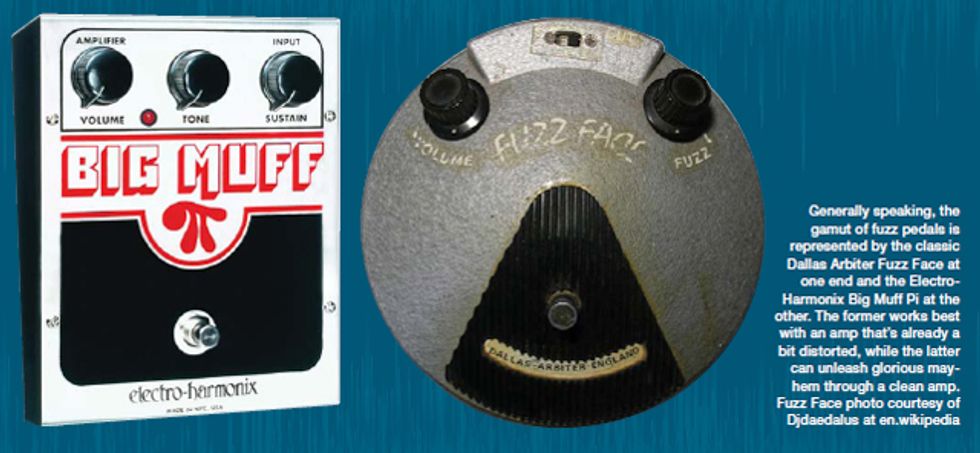
Further, though some view fuzzes as a rather blunt and imprecise sonic “weapon,” some fuzz units are as dynamic as an overdrive pedal and clean up when the guitar volume is backed off and respond well to variations in pick attack. Others do not clean up, but rather distort in a different manner.
In basic terms, the two extremes of the fuzz spectrum are represented by the original Dallas Arbiter Fuzz Face on one end and the Electro-Harmonix Big Muff on the other. If you want to produce fat single notes with lots of sustain by running a fuzz through a clean amp, à la Robert Fripp, you are better served by a Big Muff-style fuzz. Why? Because, before it serves up a singing single note, a Fuzz Face-style unit needs the help of a slightly distorted amp or overdrive pedal placed between it and the amp, as well as a guitar with its own healthy sustain and modified picking techniques (aggressive picking helps). That said, there are also many fuzz units that fall between these two extremes.
Octave fuzz comes with its own set of proper playing techniques. The upper octaves come out best on the E and B strings above the 12th fret, and they’re enhanced by using the neck pickup and rolling off the Tone knob. Octave fuzz effects are designed for single-note lines, but some groups of notes can be played harmoniously. If you are into dissonance, they offer a whole other world filled with clashing intervals to explore.
Get Dirty
As you can see and hear, distortion comes in many colors, with various shades and hues within those colors. For a more in-depth look, check out my book All About Effects (street $14.99, halleonard.com).
Experimenting with different ways of dirtying up your sound is one of the most exciting and fun things about playing electric guitar. Using the various types of stompboxes and approaches described here, you can elicit a wealth of harmonics and overtones—from sweet, singing sustain to chopped-off dissonant clang—from your guitars. Your mission— should you choose to accept it—is to make music with these marvelous tones.
10 Tips For Great Gritty Tone
There are even more ways to get crazy, beautiful, off-the-wall tones than there are distortion, overdrive, and fuzz pedals on the market. After all, every knob tweak and playing technique alters the sound of these pedals immensely—to say nothing of the rest of the rig they’re plugged into. That said, these 10 approaches never fail to yield great results.
1. Increase your impedance. Using a speaker cabinet with a greater impedance than that of your amp (for example, a 4 Ω head with an 8 Ω cabinet) can yield the same effects as an attenuator.
2. Don’t forget that less can be more. Distortion acts as compression, so the more gain you use the more it will flatten the dynamics of your playing. It will also wash out your sound and sink you into the mix. You might think you sound awesome, but all the audience will hear is a muffled roar.
3. Don’t obsess too much over germanium. While germanium fuzzes have come a long way in terms of consistently sounding good, they don’t all sound exactly the same—even the same models from the same company. If you have a chance to try a couple, do so. If you don’t hold an audition, but simply buy one and it sounds good, be glad. Don’t obsess that there might be a better one out there.
4. Pair a germanium fuzz with an overdrive. If you want the sound of a germanium boost at unity gain, try running it in front of an overdrive pedal with the overdrive’s Drive control set low and its output set below your clean amp volume.
5. Cascading overdrives adds up to distortion. You might find that cascading overdrives—running more than one in a row—provides a more desirable sound than a distortion pedal. By sending the slightly overdriven signal of one pedal into a second pedal set for a moderate amount of grit, you can achieve more distortion while maintaining an openness that is sometimes lost with a single highly distorted pedal.
6. Make sure your distortion pedal has level-boost capabilities. You won’t want to use too much, but a little is essential to keep a high-gain sound from disappearing in the mix.
7. Simple is best for the blues. For an authentic old-blues sound, a small combo and—at most—a clean boost are sufficient. If you want a more modern blues tone, overdrive or certain fuzz boxes will keep essential blues dynamics more intact than a distortion pedal.
8. Order matters. Some fuzz units need to be first in your pedalboard’s chain in order to work properly with guitar volumes and wah-wahs. Further, every distortion effect will have a different character if it’s placed, say, before a wah than it will if it comes somewhere else in the chain.
9. Don’t forget your Tone knob. Rolling it off is often the most effective way to tame fuzz fizz and make it more adaptable to different songs and feels.
10. Summon a sitar. Selecting your bridge pickup and rolling down your Volume while using an octave fuzz pedal can create a cool sitar sound—who would’ve thought?

